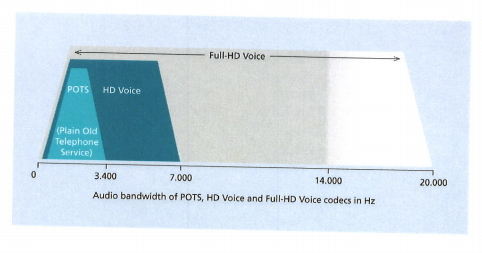Fraunhofer Announces New EVS Audio Codec For 'Media-Quality' Full-HD Voice Calls
Fraunhofer, a German research company working on improving audio technology, together with 11 other companies including Ericsson, Nokia, Qualcomm and Samsung, announced that they've developed a new Enhanced Voice Services (EVS) codec that can boost audio quality significantly.
The companies started working on the new wide-band audio codec in order to bring the same level of quality to voice calls that you hear in other media. The GSM standard uses the AMR codec, which is a speech-only codec that is limited to the human voice and shuts out everything else, including other background sounds or music. Most of the current phone services remove at least three quarters of the audible spectrum, according to Fraunhofer.
The AMR codec has a bandwidth of 300 Hz-3.4 KHz, which has recently been doubled to 7 KHz (also called "HD Voice"). The new EVS codec has a bandwidth from 14 KHz (superwideband audio) and up to 20 KHz (full band audio) and has an audio quality comparable to streaming music. EVS was designed from the ground up to work with packet-switched services such as VoLTE (Voice over LTE). Fraunhofer calls it "Full-HD Voice."
The EVS codec allows bit rates ranging from 5.9 Kbit/s to 128 Kbit/s, which allows phone service providers to optimize their networks as needed. Bit rates for narrowband and wideband start at 5.9 Kbit/s, while superwideband Full-HD Voice bit rates start at 9.6 Kbit/s.
The EVS codec includes features such as a multi-rate speech and audio codec, source controlled variable bit-rate adaptation, a voice/sound activity detector, comfort noise generation, an error concealment mechanism, a channel-aware mode, and powerful jitter buffer management.
Fraunhofer said that the audio quality of the new codec is so good that reporters could go "live-to-air" from a remote location by simply using their phones. For regular consumers, the new codec comes with benefits such as being able to listen to music from a distance, such as from a concert they're not attending, with no degradation in quality.
According to the company, the new codec could start arriving in phones within 18 months. The codec can be implemented currently in software, but it's likely to arrive in hardware in the DSP in the future in order to achieve higher performance and efficiency.
Get Tom's Hardware's best news and in-depth reviews, straight to your inbox.
Follow us @tomshardware, on Facebook and on Google+.
Lucian Armasu is a Contributing Writer for Tom's Hardware US. He covers software news and the issues surrounding privacy and security.
-
magicandy For the unaware, Fraunhofer is the company that created the MP3 codec. Not sure why the article didn't mention that right off the bat, they're not just some random newcomer audio company.Reply -
agnickolov It'd be quite useful if they tried to extend the range towards the lower end of the spectrum too, e.g. bass frequencies. Also, the chart shown is quite misleading since it is shown in a linear scale while audio frequencies are experienced by the human ear on a logarithmic scale. E.g. the expansion (over 7kHz), while certainly not insignificant, is not that big either. It's approximately 1.5 units on a base 2 logarithmic scale (2*sqrt(2)). For comparison, if the bass frequency range were to be improved 1.5 units it'd be extended to ~106Hz. The human ear can experience sound from 20Hz, so we have a lot more room for improvement there (about another 2.5 units). And the range 300Hz-7kHz has ~4.5 logarithmic units in it. The above numbers are all based on base 2 logarithms.Reply -
HPBaumeister Hi - just to add to the last commenter's remarks: agnickolov is quite correct in saying that the lower frequencies are rather important as well in achieving better communications quality and a much better audio fidelity.Reply
EVS does go down substantially lower than today's lower limit of 300 Hz for AMR or G.711: 50 Hz.
Keep in mind that usually only a fraction of the information that was exchanged during an interview actually gets into an article.
Journalists don't want to publish "White Papers", but rather inform the public about the major trends and key information/takeaways.
I am puzzled about the non-linear characteristic of human hearing however - can you explain/quote something here?
-
BrandonYoung ReplyHi - just to add to the last commenter's remarks: agnickolov is quite correct in saying that the lower frequencies are rather important as well in achieving better communications quality and a much better audio fidelity.
EVS does go down substantially lower than today's lower limit of 300 Hz for AMR or G.711: 50 Hz.
Keep in mind that usually only a fraction of the information that was exchanged during an interview actually gets into an article.
Journalists don't want to publish "White Papers", but rather inform the public about the major trends and key information/takeaways.
I am puzzled about the non-linear characteristic of human hearing however - can you explain/quote something here?
For a non-linear comparison of human hearing in reference to Hz:
take 20Hz -1000Hz, huge range of tones here, under 1KHz difference between the two. Now take 18,000Hz - 19,000Hz, almost no perceivable difference in tone, same 1KHz span.

